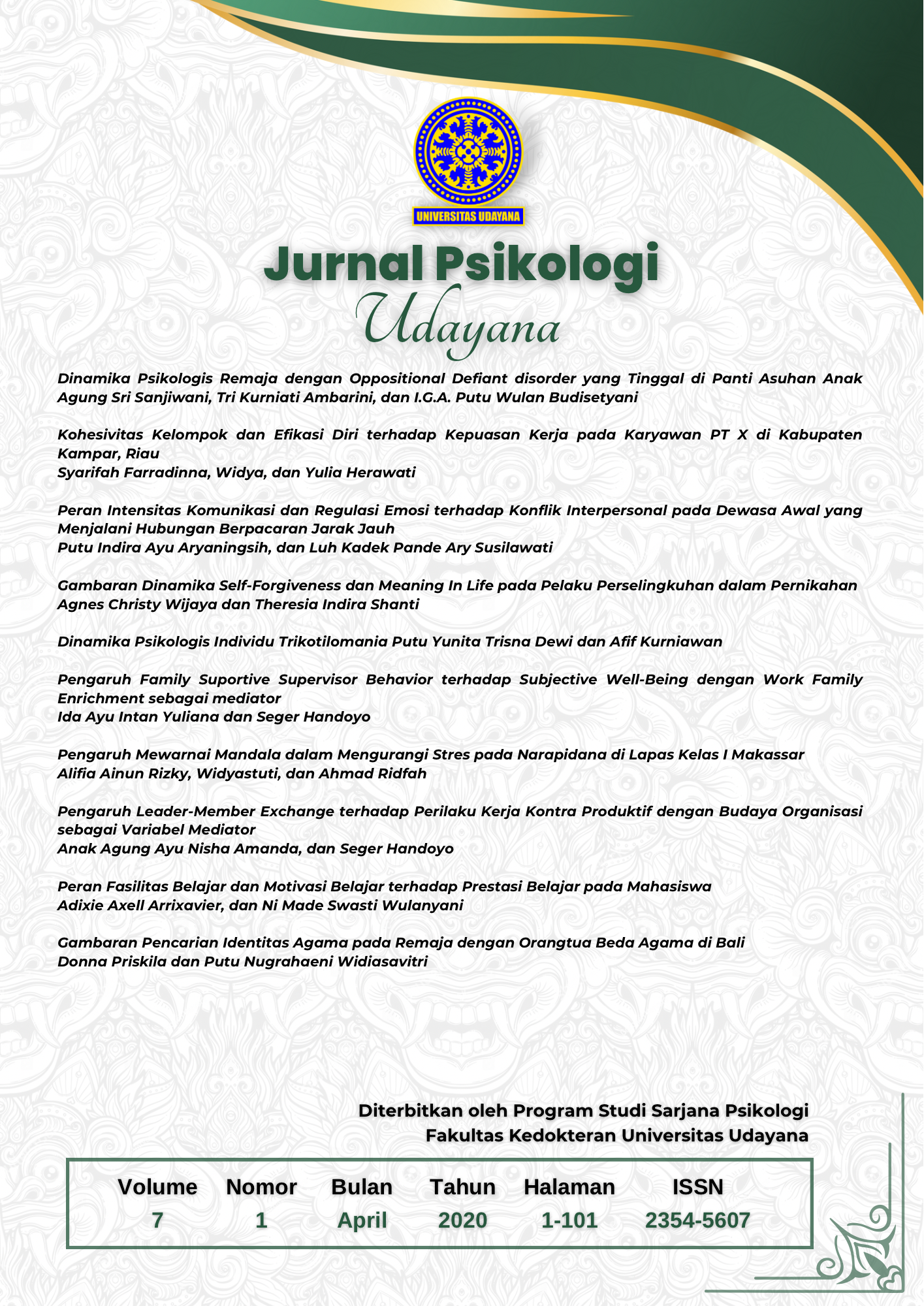Pengaruh leader-member exchange terhadap perilaku kerja kontraproduktif dengan budaya organisasi sebagai variabel mediator
Abstract
Penelitian ini bertujuan untuk mengetahui apakah terdapat pengaruh leader-member exchange terhadap perilaku kerja kontraproduktif dengan budaya organisasi sebagai variabel mediator. Definisi leader-member exchange dalam penelitian ini menggunakan teori Graen & Uhl-Bien (1995), perilaku kerja kontraproduktif menggunakan teori Fox & Spector (2005), dan budaya organisasi menggunakan teori Schein (1992). Teknik sampling yang digunakan pada penelitian ini adalah simple random sampling. Penelitian ini dilakukan pada 192 karyawan yang bekerja di Rumah Sakit X. Alat pengumpulan data yang digunakan pada penelitian ini adalah skala Leader-Member Exchange 7 (LMX7) untuk mengukur leader-member exchange, skala Counterproductive Work Behavior Checklist (CWB-C) untuk mengukur perilaku kerja kontraproduktif dan Denison Organizational Culture Survey (DOCS) untuk mengukur budaya organisasi. Analisis data yang digunakan pada penelitian ini adalah SmartPLS 3.0. Hasil penelitian menunjukkan bahwa (1) leader-member exchange berpengaruh langsung dan signifikan terhadap budaya organisasi, (2) budaya Organisasi berpengaruh langsung dan signifikan terhadap perilaku kerja kontraproduktif, (3) leader-member exchange tidak memiliki hubungan yang signifikan dengan perilaku kerja kontraproduktif, dan (4) leader-member exchange memiliki pengaruh terhadap perilaku kerja kontraproduktif dengan budaya organisasi sebagai mediator penuh.
Kata kunci: Leader-member exchange, Perilaku kerja kontraproduktif, Budaya organisasi
Downloads
References
Antonakis, J., & Day, D. V. (2017). The nature of leadership. (3rd ed). California: Sage publications.
Arif, M., Zahid, S., Kashif, U., & Sindhu, M.I. (2017). Role of leader-member exchange relationship in organizational change management: Mediating role of organizational culture. International Journal of Organizational Leadership, 32-41
Aryee, S. & Chen, Z. X. (2006). Leader-member exchange in a Chinese context: Antecedents, the mediating role of psychological empowerment and outcomes. Journal of Business Research. 59, 793-801.
Ashforth, B. E., & Humphrey, R. H. (1995). Emotion in the workplace: A reappraisal. Human relations, 48(2), 97-125
Bennett, R. J., & Robinson, S. L. (2000). Development of a measure of workplace deviance. Journal of Applied Psychology. 85, 349-360
Blau, P. M. (1964). Exchange and power in social life. New York: Wiley.
Brief, A. P., & Weiss, H. M. (2002). Organisational behavior: Affect in the workplace. Annual review of psychology. 53(1), 279-307.
Budiman. (2015). Pengaruh Kualitas Hubungan Antara Atasan Bawahan Terhadap Perilaku Kerja Kontra Produktif. Psikis Jurnal Psikologi Islam. Vol.7, No.2 (35-41).
Byun, G., Dai, Y., Lee, S., & Kang, S. (2017). Leader Trust Competence, LMX, and Member Perfomance: A Moderated Mediation Framework. Psychological Reports, 120(6), 1137-1159.
Chen, C. C., Chen, M. Y. C., & Liu, Y. C. (2013). Negative affectivity and workplace deviance: The moderating role of ethical climate. The International Journal of Human Resource Management, 24(15), 2894-2910
Chernyak-Hai, L., & Tziner, A. (2014). Relationship between counterproductive work behavior, perceive justice and climate, occupational status, and leader-member exchange. Revista de Psicologia del Trabajo y de las Organizaciones, 30(1), 1-12.
Colquitt, J., A. Jeffery, A., LePine., Wesson, M., J. (2011). Organizational behavior: Improving performance and commitment in the workplace. McGraw-Hill Irwin
Cullen, M.J., & Sackett, P.R. (2003). Personality and counterproductive workplace behavior. Personality and work: Reconsidering the role of personality in organizations, 14(2), 150-182.
Danserau, F., Graen, G., & Haga, W.J. (1975). A vertical dyad linkage approach to leadership within formal organizations: A longitudinal investigation of the role making process. Organizational behavior and human performance, 13(1), 46-78.
Davidovits, R., Mikulincer, M., Shaver, P. R., Izsak, R., & Popper, M. (2007). Leaders as attachment figures: leader’s attachment orientations predict leadership-related mental representations and follower’s performance and mental health. Journal of mental health and social psychology, 93(3), 632-650.
Denison, D., R, & Mishra, A.K. (1995). Toward a theory of organizational culture andeffectiveness. Organization Science, 6(2), pp. 204-23.
Dienesch, R. M., & Liden, R. C. (1986). Leader-member exchange model of leadership: A critique and further development. Academy of Management Journal, 11, 618634
Douglas, S. C., & Martinko, M. J. (2001). Exploring the role of individual differences in the prediction of workplace aggression. Journal of Applied Psychology, 86, 547-559
Efflesberg, D., Solga, M., & Gurt, J. (2014). Transformational leadership and and follower’s unethical behavior for the benefit of the company: A two-study Investigation. Journal of Business Ethics, 120(1), 81-93
Erdogan, B., Liden, R. C., & Kraimer, M. L. (2006). Justice and leader-member exchange: The moderating role of organizational culture. Academy of Management Journal, 49, 395-406
Esmi K., Piran M., & Hayat AA. (2017) An examination of the mediating effect of organizational culture on the relationship between transformational leadership and organizational citizenship behavior. J Health Man & Info. 4(4), 114-119.
Ford, R. C., Wilderom, C. P. M. & Caparella, J. (2008). Strategically crafting a customer-focused culture: an inductive case study. Journal of Strategy and Management, 1, 143-167.
Frost, B. C., Ko, C. H., & James, L. R. (2007). Implicit and explicit personality: A test of a channeling hypothesis for aggressive behavior. Journal of Applied Psychology, 92, 1299-1319
Gouldner, A.W. (1960). The norm of reciprocity: A preliminary statement. American sociological review, 167-178.
González-Romá, V. (2016). Leader-member exchange and organizational culture and climate. In T. Bauer & B. Erdogan (Eds.), The Oxford Handbook of Leader-Member Exchange (pp. 311-331). New York: Oxford University Press.
Graen, G. B. (2003). Interpersonal workplace theory at the crossroads: LMX and transformational theory as special cases of role making in work organizations. In G. B. Graen (Ed.), Dealing with diversity (pp. 145–182). Greenwich: Information Age Publishin
Graen, G. B., & Cashman, J. (1975). A role‐making model of leadership in formal organizations: A development approach. In J. G. Hunt & L. L. Larson (Eds.), Leadership frontiers (pp. 143–166). Kent, OH: Kent State University Press.
Graen, G. B., & Uhl-Bien, M. (1995). Relationship-based approach to leadership: Development of leader–member exchange (LMX) theory of leadership over 25 years: Applying a multi-level, multi-domain perspective. Leadership Quarterly, 6, 219–247
Harper, D. (1990). Spotlight abuse – Save profits. Industrial Distribution, 79, 47-51.
Ilies, R., Fulmer, I.S., Spitzmuller, M., & Johnson, M.D. (2009). Personality and citizenship behavior: the mediating role of job satisfaction. Journal of applied psychology, 94(4), 945-959.
Jawahar, I., Schreurs, B., & Mohammed, S. (2018). How and when LMX quality relates to counterproductive performance: A mediated moderation model Career Development International, 23(6), 557-575.
Johns, G. (2017). Reflections on the 2016-decade award: incorporating context in organizational research, Academy of Management Review. 4(42), 577-595.
Kanungo, R.N. (2001). Ethical values of transactional and transformational leaders. Canadian Journal of Administrative Science/Revenue Canadiene des Sciences de l’administration, 18(4), 257-265.
Kaptein, M. (2008). Developing and testing a measure for the ethical culture of organisations: The corporate ethical virtues model. Journal of Organisational Behavior, 29(7), 923-947
Liden, R. C. & Graen, G. B. (1980). Generalizability of the vertical dyad linkage model of leadership. Academy of Management Journal, Vol. 23 No. 3, 451-465.
Liu, S.M., Liao, J.Q., & Wei, H. (2015). Authentic leadership and whistleblowing
Major, D. A., Fletcher, T. D., Davis, D. D. & Germano, L. M. (2008). The influence of work-family culture and workplace relationships on work interference with family: a multilevel model. Journal of Organizational Behavior, 29, 881-897
Martin, R., Thomas, G., Guillaume, Y., Lee, A. & Epitropaki, O. (2016). Leader-member Exchange (LMX) and Performance: A Meta-Analytic Review. Personnel Psychology, 69, 67-121.
Miller, D. (2001). Successful change leader: what makes them? What do they do that is different? Journal of Change Management, 2(4), 359-368
Nahrgang, J.D., Morgeson, F.P., & Ilies, R. (2009). The development of leader-member exchanges: Exploring how personality and performance influence leader and member relationship over time. Organizational Behavior and Human Decision Process, 108(2), 256-266.
Neuman, W. L. (2013). Metodologi Penelitian Sosial Pendekatan Kualitatif dan Kuantitatif Edisi 7. Jakarta: Indeks.
Othman, R., Ee, F. F., & Shi, N. L. (2009). Understanding dysfunctional leader-member exchange: Antecedents and outcomes. Leadership & Organization Development Journal, 31, 337-350
Parisa, A., Jalil, D., & Mansour, K. (2016). Counterproductive Behaviors in State Hospitals: A Review of the Role of Organizational Cynicism and Injustice. Mediteranian Journal of Social Sciences, 7 (4), 196-207.
Pearson, A. W. & Marler, L. E. (2010). A Leadership Perspective of Reciprocal Stewardship in Family Firms. Entrepreneurship Theory and Practice, 6, 1117-1124.
Penney, L. H., Hunter, E. M., & Perry, S.J. (2011). Personality and counterproductive work behavior: using conservation of resources theory to narrow the profile of deviant employees. Journal of Occupational and Organizational Psychology, 84(1), 58-77.
Premru, M. (2019). The Relationship Between Leader-Member Exchange and Counterproductive Work Behavior. Dissertation and Thesis. Faculty of Economics University Ljubljana
Robinson, S. L., & Bennett, R. J. (1995). A typology of deviant workplace behaviors: A multidimensional scaling study. Academy of Management Journal, 38, 555–572.
Rockstuhl, T., Dulebohn, J., Ang, S., Shore, L, M. (2012). Leader-Member Exchange (LMX) and Culture: A Meta Analysis of Correlates of LMX Across 23 Countries. Journal of Applied Psychology. 97 (6), pp. 1097-1130.
Schwartz, M. S. (2013). Developing and sustaining an ethical corporate culture: The core elements. Business horizons, 56(1), 39-50
Schein, E. H, (1992). Organizational Culture and Leadership. Jossey Bass, San Francisco
Sequiera, A.H., & Dhriti, A. (2015). Employee Relations and Its Impact On Employee Perfomance: A Case Study
Sharma, A., & Thakur, K. (2016). Counterproductive Work Behavior: The Role of Psychological Contract Violation. International Journal of Multidisciplinary Approach and Studies, 3(1), 13–27
Shore, L. M., Tetrick, L. E., Lynch, P., & Barksdale, K. (2006). Social and economic exchange: Construct development and validation. Journal of Applied Social Psychology, 36(4), 837-867
Sparrowe, R. T., Soetjipto, B. W., & Kraimer, M. L. (2006). Do leaders' influence
tactics relate to members' helping behavior? It depends on the quality of the relationship. Academy of Management Journal, 49, 1194-1208.
Spector, P. E., & Fox, S. (2002). An emotion-centered model of voluntary work behavior: Some parallels between counterproductive work behavior and organisational citizenship behavior. Human Resource Management Review,12(2), 269-292.
Spector, P. E., Fox, S., Penney, L. M., Bruursema, K., Goh, A., & Kessler, S. (2006). The dimensionality of counterproductivity: Are all counterproductive behaviors created equal? Journal of Vocational Behavior, 68, 446-460.
Spector, P. E., & Fox, S. (2005). A model of counterproductive work behavior. In S. Fox & P. E. Spector (Eds.), Counterproductive workplace behavior: Investigations of actors and targets (pp. 151-174). Washington, D.
Taylor, O.A. The relationship between culture and counterproductive workplace behavior: A meta-analysis. [Thesis]. The School of Graduate and Postdoctoral Studies the University of Western Ontario London, Ontario, Canada.
Townsend, J., Phillips, J. S., & Elkins, T. J. (2000). Employee retaliation: The neglected consequence of poor leader–member exchange relations. Journal of Occupational Health Psychology. 5, 457-463.
Tse, H.H., Lam, C.K., Gu, J., & Lin, X. S. (2012). Relative leader-member exchange, negative affectivity, and social identification: A moderated-mediation examination. The Leadership Quarterly, 23(3), 354-366.
Zaghini, F., Fida, R., Caruso, R., Kangasniemi, M., & Sili, A. (2016) What is Behind Counterproductive Work Behaviors in the Nursing Profession? Journal of Clinical Research & Bioethics, 7 (4), 1-7

This work is licensed under a Creative Commons Attribution-ShareAlike 4.0 International License.
Authors who publish with this journal agree to the following terms:
- Authors retain copyright and grant the journal right of first publication with the work simultaneously licensed under a Creative Commons Attribution-ShareAlike 4.0 International License that allows others to share the work with an acknowledgement of the works authorship and initial publication in this journal.
- Authors are able to enter into separate, additional contractual arrangements for the non-exclusive distribution of the journals published version of the work (e.g., post it to an institutional repository or publish it in a book), with an acknowledgement of its initial publication in this journal.
- Authors are permitted and encouraged to post their work online (e.g., in institutional repositories or on their website) prior to and during the submission process, as it can lead to productive exchanges, as well as earlier and greater citation of published work (See The Effect of Open Access).













